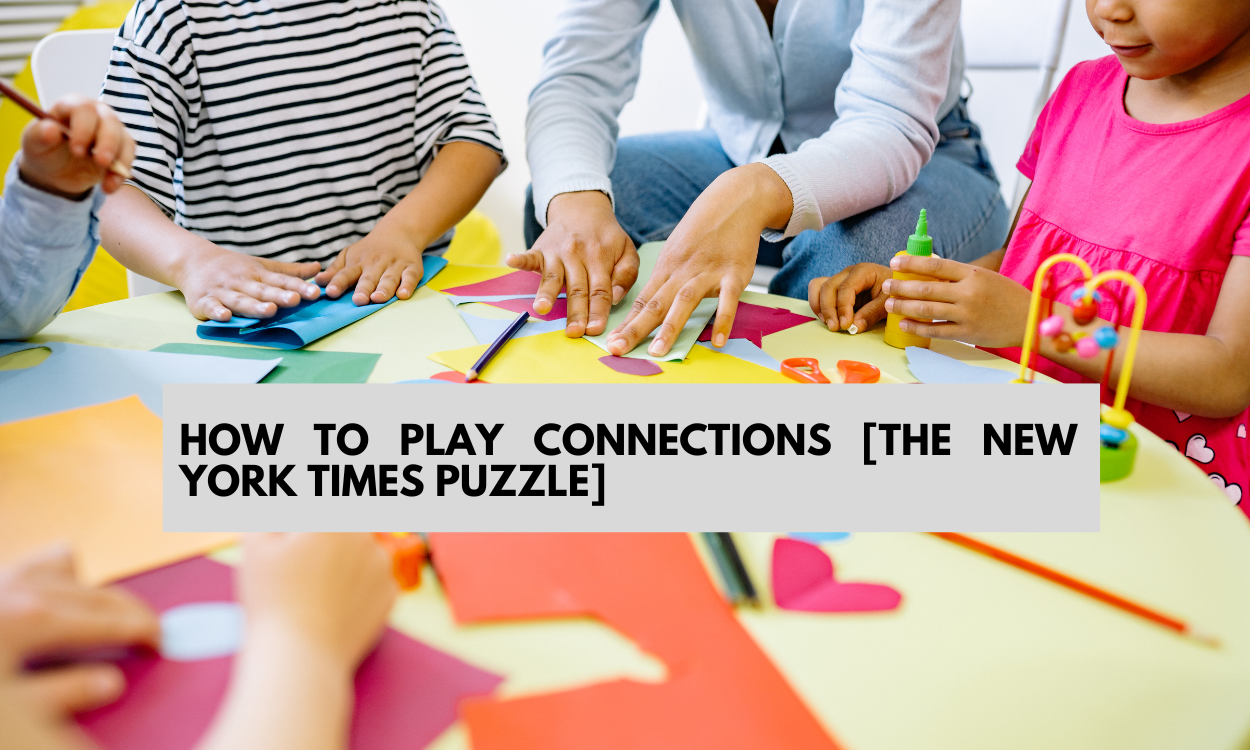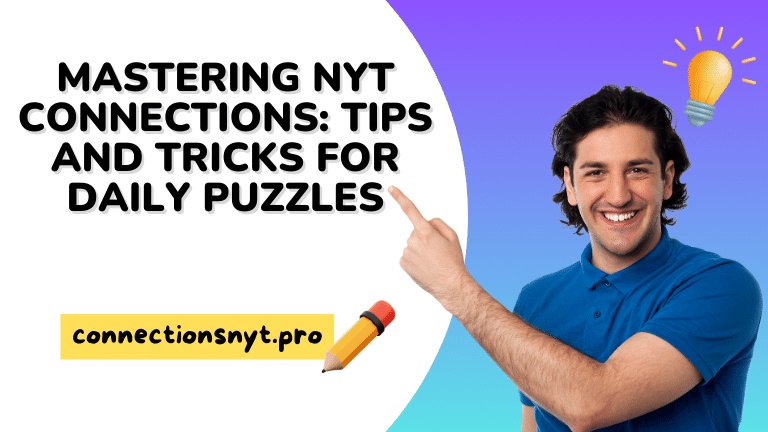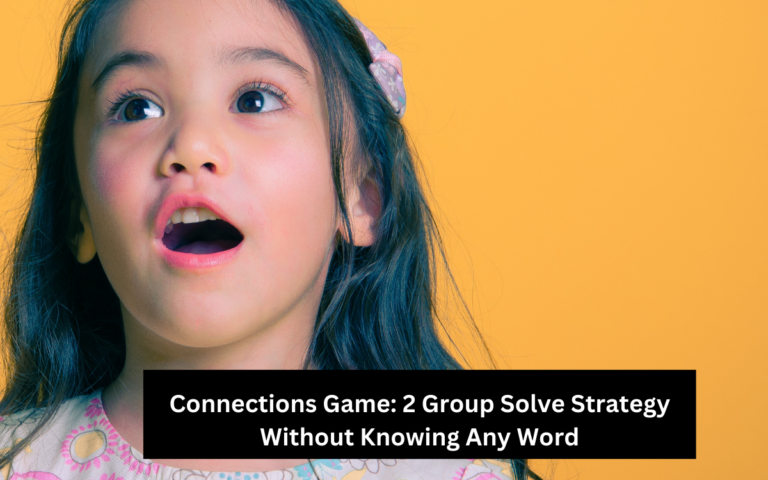How To Play Connections [The New York Times Puzzle]
How To Play Connections The New York Times Puzzle.The New York Times has long been known for its challenging and addictive word games, with the crossword puzzle being a staple for decades. Now, a new contender has entered the arena: Connections. This innovative puzzle game has taken the internet by storm, offering a fresh challenge for word enthusiasts and puzzle lovers alike. In this comprehensive guide, we’ll explore everything you need to know about how to play Connections, strategies for success, and why it’s becoming the latest obsession for puzzle aficionados.
What is Connections?
Before diving into the gameplay, let’s understand what Connections is and how it fits into the New York Times puzzle lineup.
A New Addition to the NYT Games Family
Connections is the latest addition to the New York Times Games portfolio, joining beloved classics like the Crossword, Spelling Bee, and Wordle. Launched in 2023, it quickly gained popularity for its unique approach to word puzzles.
The Basic Concept
At its core, Connections is a word association game. Players are presented with a grid of 16 words and must identify four groups of four words that share a common theme or connection. The challenge lies in discerning these often subtle or unexpected relationships between words.
How to Access Connections
Getting started with Connections is straightforward, but there are a few things to know about accessing the game.
New York Times Games Subscription
Connections is part of the New York Times Games subscription service. While some NYT games offer limited free plays, Connections typically requires a subscription to play regularly.
Where to Find It
- Visit the New York Times website (nytimes.com)
- Navigate to the Games section
- Look for Connections in the list of available games
- Click to start playing
Mobile App Availability
For on-the-go play:
- Download the New York Times Crossword app
- Find Connections in the game selection menu
- Enjoy playing on your mobile device
The Gameplay Explained
Now that you know how to access the game, let’s break down how to play Connections step by step.
The Game Board
When you start a new Connections puzzle, you’ll see:
- A 4×4 grid containing 16 words
- Four empty colored boxes below the grid
- A moves counter and timer at the top of the screen
The Objective
Your goal is to:
- Identify four groups of four words
- Each group should share a common theme or connection
- Correctly categorize all 16 words into their respective groups
Making Selections
To play:
- Tap or click on words you believe are connected
- Select four words you think belong together
- Submit your selection to check if you’re correct
Feedback and Progress
After submitting a selection:
- If correct, the words will be removed from the grid and placed in one of the colored boxes
- If incorrect, you’ll receive a notification and can try again
- The game tracks your number of incorrect guesses
Winning the Game
To complete the puzzle:
- Successfully identify all four groups of four words
- Do so within the allowed number of incorrect guesses (typically 4)
Understanding Connections Categories
The heart of Connections lies in recognizing the themes that link words together. Let’s explore the types of categories you might encounter.
Common Category Types
- Synonyms or related words
- Items in a specific category (e.g., types of fruit, car brands)
- Words that can follow or precede a common word
- Phrases or idioms
- Pop culture references (movies, TV shows, music)
- Historical or geographical connections
Example Categories
To illustrate, here are some example categories you might find in a Connections puzzle:
- Colors: BLUE, RED, GREEN, YELLOW
- Parts of a house: ROOF, DOOR, WINDOW, FLOOR
- Words that can follow “BOOK”: WORM, CLUB, MARK, END
- Beatles songs: HELP, YESTERDAY, HEY JUDE, LET IT BE
Difficulty Levels
Categories can range from obvious to extremely subtle:
- Yellow (Easiest): Straightforward connections
- Green (Medium): Require some thought but generally recognizable
- Blue (Hard): More obscure or require specific knowledge
- Purple (Hardest): Often involve wordplay or very subtle connections
Strategies for Success in Connections
Mastering Connections requires a combination of word knowledge, lateral thinking, and strategy. Here are some tips to improve your game.
Start with the Obvious
- Look for words that clearly go together (e.g., colors, numbers)
- Identifying an easy group can help narrow down the remaining options
Consider Multiple Meanings
- Remember that words can have different contexts
- A word might fit into multiple potential categories
Use Process of Elimination
- If you’re unsure about a group, try eliminating words that don’t fit
- Sometimes it’s easier to see what doesn’t belong than what does
Look for Patterns
- Pay attention to word length or structure
- Sometimes all words in a group might end in the same letters or have a similar format
Think About Word Associations
- Consider words that might precede or follow each word
- Look for common phrases or idioms
Leverage Your Knowledge
- Draw on your understanding of various subjects (history, pop culture, science)
- Don’t be afraid to make educated guesses based on your general knowledge
Be Mindful of Recent Events
- Connections often includes topical or current event-related categories
- Stay informed about recent news, trends, or popular culture
Use Your Guesses Wisely
- Remember, you typically have only 4 incorrect guesses
- If you’re unsure, it might be better to keep thinking rather than guessing randomly
Common Pitfalls and How to Avoid Them
Even experienced players can fall into certain traps when playing Connections. Here are some common mistakes and how to avoid them.
Overthinking Easy Categories
- Don’t assume every category is complex
- Sometimes the simplest connection is the correct one
Ignoring Context Clues
- Pay attention to how words are spelled or formatted
- Capitalization or punctuation can sometimes be a hint
Rushing Through the Puzzle
- Take your time to consider all possibilities
- The timer is there for reference, not to stress you out
Fixating on Incorrect Connections
- If a group doesn’t work, be willing to completely rethink your approach
- Don’t get stuck on a particular idea if it’s not yielding results
Neglecting Less Familiar Words
- If there’s a word you don’t recognize, don’t ignore it
- It might be key to understanding a category
Forgetting About Wordplay
- Be open to puns, homophones, or other word tricks
- Especially in the more difficult categories, wordplay is often involved

Advanced Techniques for Connections Mastery
Once you’ve got the basics down, consider these advanced strategies to take your Connections game to the next level.
Develop a Systematic Approach
- Create a mental checklist of category types to consider
- Develop a routine for how you scan and analyze the word grid
Expand Your Vocabulary
- Read widely across various subjects
- Pay attention to word etymologies and relationships
Study Past Puzzles
- Look at the solution explanations for puzzles you’ve completed
- Try to understand the logic behind categories you missed
Practice Word Association
- Play other word association games to sharpen your skills
- Try creating your own connections outside of the game
Collaborate and Discuss
- Join online communities or forums dedicated to Connections
- Discuss strategies and challenging puzzles with other players
Analyze Your Performance
- Keep track of the types of categories you struggle with
- Focus on improving in your weak areas
The Psychology Behind Connections
Understanding the cognitive processes involved in solving Connections puzzles can help you approach the game more effectively.
Pattern Recognition
- The game relies heavily on our brain’s ability to recognize patterns
- Practice can improve your pattern recognition skills over time
Semantic Networks
- Connections taps into our mental web of word associations
- Strengthening these networks can enhance your gameplay
Cognitive Flexibility
- The game requires you to switch between different ways of thinking
- Developing cognitive flexibility can improve your problem-solving skills
Memory Retrieval
- Success often depends on quickly recalling information
- Regular play can enhance your ability to access stored knowledge
Connections vs. Other Word Games
How does Connections compare to other popular word games? Let’s explore its unique features and challenges.
Connections vs. Crossword Puzzles
- Connections relies more on associations than definitions
- It requires a different type of lateral thinking
Connections vs. Wordle
- Connections involves multiple words rather than guessing a single word
- It tests a broader range of word knowledge and associations
Connections vs. Spelling Bee
- Connections doesn’t focus on word construction
- It emphasizes relationships between words rather than letter patterns
The Cultural Impact of Connections
Since its launch, Connections has made a significant impact on puzzle culture and social media.
Social Media Buzz
- Players often share their results on platforms like Twitter
- Discussions and debates about difficult puzzles are common online
Community Building
- Connections has fostered a community of dedicated players
- Online groups and forums have sprung up to discuss strategies and solutions
Educational Value
- The game is being recognized for its potential in vocabulary development
- Some educators are incorporating it into language and cognitive skills training
The Future of Connections
As Connections continues to grow in popularity, what might the future hold for this engaging puzzle game?
Potential New Features
- Multiplayer or competitive modes
- Customizable difficulty levels
- Theme-specific puzzle sets
Educational Applications
- Integration into language learning curricula
- Development of Connections-style exercises for cognitive training
Technological Advancements
- AI-generated puzzles for unlimited play
- Virtual reality or augmented reality versions of the game
Conclusion
Connections has quickly established itself as a worthy addition to the New York Times’ lineup of addictive word games. Its unique blend of word association, general knowledge, and lateral thinking provides a fresh challenge for puzzle enthusiasts and casual players alike.
By understanding the game mechanics, employing effective strategies, and continuously expanding your knowledge base, you can improve your Connections skills and enjoy the daily mental workout it provides. Remember, the key to success lies not just in your vocabulary, but in your ability to see the hidden links between words and concepts.
Whether you’re a seasoned word game veteran or new to the world of puzzles, Connections offers something for everyone. Its blend of accessibility and depth ensures that each day brings a new and engaging challenge. So, dive in, start making those connections, and join the growing community of players who have made this game their daily mental exercise.
As you continue to play and improve, you’ll likely find that Connections does more than just entertain – it enhances your cognitive flexibility, expands your knowledge, and provides a delightful way to keep your mind sharp. Happy connecting!
FAQs
How often are new puzzles released?
New Connections puzzles are typically released daily, like many other New York Times games.
Can I play old puzzles?
Currently, Connections focuses on the daily puzzle, but archives may become available in the future.
Is there a time limit?
While there’s a timer displayed, it’s for reference only. You can take as long as you need to solve the puzzle.
How are the difficulty levels determined?
The New York Times Games team carefully crafts each puzzle, assigning difficulty levels based on the obscurity and complexity of the connections.
Can I play Connections for free?
While some NYT games offer limited free plays, Connections typically requires a subscription to the New York Times Games service.




![Connections Puzzle Game NYT – Play Unlimited Free [2024]](https://connectionsnyt.pro/wp-content/uploads/2024/06/Connections-NYT-Ranked-Best-Educational-Game-For-2024-22-768x480.png)
![What Connects These Four Loose Split Dead Book NYT? [2024]](https://connectionsnyt.pro/wp-content/uploads/2024/04/What-Connects-These-Four-Loose-Split-Dead-Book-NYT.png)

